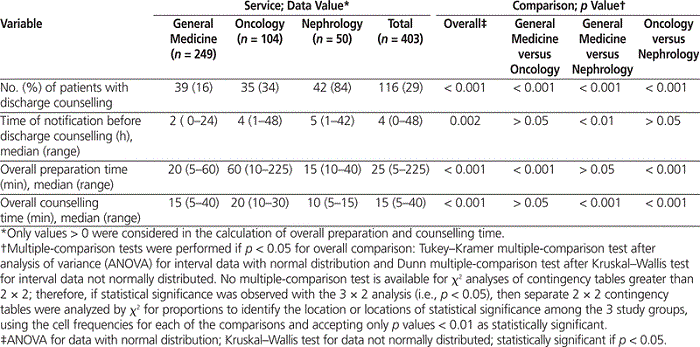
Sandra A N Walker , Jennifer K Lo , Sara Compani , Emily Ko , Minh-Hien Le , Romina Marchesano , Rimona Natanson , Rahim Pradhan , Grace Rzyczniak , Vincent Teo , Anju VyasABSTRACT
Background
Medication errors may occur more frequently at discharge, making discharge counselling a vital facet of medication reconciliation. Discharge counselling is a recognized patient safety initiative for which pharmacists have appropriate expertise, but data are lacking about the barriers to provision of this service to adult inpatients by pharmacists.
Objectives:
To determine the proportion of eligible patients who received discharge counselling, to quantify perceived barriers preventing pharmacists from performing discharge counselling, and to determine the relative frequency of barriers and associated time expenditures.
Methods:
In this prospective study, 8 pharmacists working in general medicine, medical oncology, or nephrology wards of an acute care hospital completed a survey for each of the first 50 patients eligible for discharge counselling on their respective wards from June 2010 to February 2011. Patients discharged to another facility (rehabilitation, palliative care, or long-term care), those with hospital stay less than 48 h before discharge, and those whose medications were unchanged from hospital admission were ineligible.
Results:
Discharge counselling was performed for 116 (29%) of the 403 eligible patients and involved a median preparation time of 25 min and median counselling time of 15 min per patient. At least one documented barrier to discharge counselling existed for 295 (73%) of the patients. Several barriers to discharge counselling occurred significantly more frequently on the general medicine and oncology wards than on the nephrology ward ( p < 0.05). The most common barrier was failure to notify the pharmacist about impending patient discharge (130/313 [41%]). Time constraints existed for 130 (32%) of the patients, the most common related to clarification of prescriptions (96 [24%]), creation of a medication list (69 [17%]), and faxing of prescriptions (64 [16%]).
Conclusion:
This study generated objective data about the barriers to and time constraints associated with medication discharge counselling by pharmacists. These findings should raise awareness of the challenges faced by pharmacists in busy hospital positions and may support avenues of change for their hospital discharge counselling programs.
KEYWORDS: barriers to discharge counselling
RÉSUMÉ
Contexte :
Les erreurs de médication peuvent être plus fréquentes lors du congé, ce qui fait de l’offre de conseils au moment du congé un élément essentiel du bilan comparatif des médicaments. L’offre de conseils au moment du congé est un service dont la valeur quant à la sécurité des patients est reconnue et pour lequel les pharmaciens possèdent l’expertise nécessaire. Toutefois il y a trop peu de données sur les éléments qui font obstacle à l’offre de ce service aux patients hospitalisés par les pharmaciens.
Objectifs :
Définir quelle est la proportion de patients admissibles ayant obtenu des conseils au moment du congé, quantifier les éléments perçus comme des obstacles qui empêchent les pharmaciens d’offrir ce service et déterminer la fréquence relative des obstacles ainsi que les contraintes de temps qui y sont associées.
Méthodes :
Dans cette étude prospective, huit pharmaciens travaillant aux services de médecine générale, d’oncologie médicale ou de néphrologie dans un hôpital de soins de courte durée ont rempli un questionnaire pour chacun des 50 premiers patients admissibles à une offre de conseils au moment où ceux-ci prenaient congé de leurs services respectifs entre juin 2010 et février 2011. Les patients transférés dans un autre établissement (réadaptation, soins palliatifs ou soins de longue durée), ceux dont le séjour à l’hôpital était de moins de 48 h avant le congé et ceux dont la médication est demeurée inchangée pendant leur séjour à l’hôpital n’étaient pas admissibles.
Résultats :
Un service de conseils au moment du congé a été fourni à 116 (29 %) des 403 patients admissibles. Il nécessitait en moyenne un temps de préparation de 25 minutes et un temps d’offre de conseils de 15 minutes par patient. Au moins un obstacle à l’offre de conseils au moment du congé a été relevé pour 295 (73 %) patients. De multiples obstacles à l’offre de conseils étaient beaucoup plus fréquents aux services de médecine générale et d’oncologie qu’à celui de néphrologie ( p < 0,05). Le plus fréquent était que l’on négligeait d’informer le pharmacien du congé imminent du patient (130/313 [41 %]). Des contraintes de temps ont été relevées pour 130 (32 %) patients, les raisons les plus courantes étant reliées à la clarification des ordonnances (96 [24 %]), à la création d’une liste de médicaments (69 [17 %]) et à la télécopie d’ordonnances (64 [16 %]).
Conclusion :
Cette étude a produit des données objectives sur les éléments qui font obstacle à la prestation par les pharmaciens de conseils en matière de médicament au moment du congé et sur les restrictions de temps qui y sont associées. Ces résultats devraient mieux faire connaître les problèmes auxquels font face les pharmaciens hospitaliers affairés et ils peuvent fournir des pistes de changement à leurs programmes de prestation de conseils au moment du congé.
MOTS CLÉS: obstacles à l’offre de conseils au moment du congé
[Traduction par l’éditeur]
Medication errors may occur more frequently at discharge, making discharge counselling a vital facet of medication reconciliation.1,2 However, data identifying barriers that prevent pharmacists from performing discharge counselling for adult inpatients are lacking.
Discharge counselling is an important, well-recognized patient safety initiative, and pharmacists have the expertise to optimally provide such counselling. The 2010 accreditation standards for pharmacy practice residencies set out by the Canadian Hospital Pharmacy Residency Board (CHPRB),* a board of the Canadian Society of Hospital Pharmacists (CSHP), outlined the criteria required for accreditation of pharmacy residency programs in Canadian hospitals.2 One of the mandates of the CHPRB is to seek evidence that the hospital is creating individualized treatment plans for patients, is providing education to patients about their medications, and can give assurance that a system is in place to support continuity of care. Institutional support for an environment conducive to pharmacists providing discharge counselling is required to ensure that each of these CHPRB requirements is met.
In addition, CSHP and the Institute for Safe Medication Practices Canada have issued a position statement on medication reconciliation, expressing their support of a leadership role for pharmacists to ensure comprehensive and timely medication reconciliation.3 There is a risk of serious medication errors occurring during transitions in care, including the point of discharge. The position statement recommends that on discharge, the patient and the next health care provider should receive an updated medication plan, including the generic name, dose, frequency, route of administration, reason for use, and duration of therapy for each medication.3
The CSHP 2015 practice excellence initiative for pharmacists in hospitals and related healthcare settings identifies as one of its objectives (objective 1.4) that by 2015, “75% of hospital inpatients discharged with complex and high-risk medication regimens will receive medication counselling managed by a pharmacist.” However, in a survey conducted by CSHP in 2011, only 3% of hospitals indicated that they currently met this standard.4 Subsequently, in 2012, through a survey of hospital pharmacy directors and managers, CSHP reported this objective to be fully implemented in only 7% of hospitals.5 Pharmacists at the authors’ hospital hypothesized that they were likely not meeting the CSHP 2015 discharge counselling target of 75%; however, objective data to assess the hypothesis were lacking. To develop an environment that supports discharge counselling, it is important to identify the barriers that prevent pharmacists from performing this important component of their role. Therefore, the objective of the current study was to identify the proportion of eligible patients who received discharge counselling, to quantify perceived barriers that prevented pharmacists from performing medication discharge counselling, and to determine the relative frequency of these barriers and the associated time expenditure.
This study was conducted at Sunnybrook Health Sciences Centre, a 1212-bed adult teaching hospital in Toronto, Ontario. Eight acute care hospital pharmacists, each functioning as a liaison clinical pharmacist for a general medicine ( n = 5), oncology ( n = 2), or nephrology ( n = 1) medical ward, participated in this prospective study. The wards were selected according to administrative assignment of pharmacists by the principal investigator (S.A.N.W.) within her continuing professional development/pharmaceutical care group. In the future, a similar evaluation may be conducted for a larger group of acute care inpatient wards.
For each of the first 50 eligible patients discharged from each pharmacist’s medical ward following initiation of the study, the pharmacist completed a survey that itemized pre-identified potential barriers to the performance of discharge counselling. The pharmacists were also involved in developing the survey tool used in the study. Data were entered in standardized data collection forms either electronically or manually and were sent electronically or returned directly to the principal investigator (S.A.N.W.) between June 2010 and February 2011.
Patients were ineligible for counselling if they were to be discharged to another facility (rehabilitation, palliative care, or long-term care), had a hospital stay of less than 48 h before discharge, or had medications at discharge that were unchanged from those in effect at hospital admission. All other patients were eligible for discharge counselling.
For this descriptive study, a sample size of convenience was used. A sample size of 400 surveys (8 pharmacists each completing 50 surveys) was selected as a reasonable number to identify potential barriers to medication discharge counselling, along with their relative frequency of occurrence and associated time expenditure.
Descriptive statistics were used to report the number of occurrences and the frequency of occurrence of each pre-identified barrier.
Barriers and time constraints were compared among the general medicine, oncology, and nephrology services using analysis of variance (ANOVA), for interval data that were normally distributed with similar standard deviations, or the Kruskal–Wallis test, for interval data that were not normally distributed or did not have similar standard deviations. Multiple-comparison tests were completed if p < 0.05 for overall comparisons: the Tukey–Kramer multiple-comparison test after ANOVA for interval data that were normally distributed or the Dunn multiple-comparison test after the Kruskal–Wallis test for interval data that were not normally distributed or had unequal standard deviations (using InStat3 software, GraphPad Software Inc).
The frequency of occurrence of each pre-identified barrier was compared among the 3 services, using the χ2 test for proportions (using MSExcel 2007, Microsoft). Statistical significance was assigned as p < 0.05 for a significant difference in the total χ2 contingency table, with p < 0.01 being required for a given cell in the χ2 contingency table to be considered a site of the observed difference.
χ2 for goodness of fit was used to identify any differences in the incidence of barriers and time constraints among surveys completed for patients who received counselling and also among surveys completed for patients who did not receive counselling (MSExcel 2007). The Fisher exact test was used to compare the incidence of barriers and time constraints between those who did and did not receive counselling (InStat3). The Mann–Whitney U test was used to compare notification time before discharge, overall preparation time, and overall counselling time between surveys completed for patients who did and did not receive discharge counselling (InStat3). Statistical significance was set at p < 0.05.
From June 2010 to February 2011, a total of 403 surveys itemizing the barriers to discharge counselling by pharmacists and the associated time constraints were collected from 8 acute care hospital wards at Sunnybrook Health Sciences Centre. The returned surveys consisted of 249 from general medicine wards, 104 from oncology wards, and 50 from the nephrology service.
Overall, only 29% (116/403) of eligible patients received discharge counselling (Table 1). Although the rate of discharge counselling was relatively high, 84% (42/50), on the nephrology ward, it was only 16% (39/249) on the general medicine wards and 34% (35/104) on the oncology units ( p < 0.001) (Table 1).
Table 1.
Discharge Counselling Summary

The median overall preparation time for discharge counselling was 25 min per patient (range 5–225 min), and the median counselling time was 15 min per patient (range 5–40 min) (Table 1). Preparation time was longest for the oncology pharmacists, who spent a median of 60 min per patient (range 10–225 min) preparing for discharge counselling ( p < 0.001 for comparisons with general medicine and nephrology wards) and 20 min per patient (range 10–30 min) conducting the actual patient education (Table 1). Median counselling time was significantly shorter on the nephrology service than on the general medicine and oncology services ( p < 0.001 for both comparisons) (Table 1).
Overall, the pharmacist on the nephrology service experienced significantly fewer barriers to discharge counselling than those on either the general medicine or oncology wards ( p < 0.001) (Table 2). Failure to notify the pharmacist about impending patient discharge and failure to write the discharge prescription in a timely manner both occurred significantly less frequently on the nephrology service ( p < 0.01) (Table 2). Also contributing to differences in rates of discharge counselling on their respective wards was the significantly shorter notification time for discharge counselling given to pharmacists on the general medicine service than to the pharmacist covering nephrology ( p < 0.01) (Table 1). The proportion of surveys indicating at least one time constraint (or preparation activity for discharge counselling) was higher on the nephrology ward, which reflects the larger proportion of patients who received counselling on that unit ( p < 0.001) (Table 3). The time spent in creating medication lists ( p < 0.001) and coordinating special medications ( p < 0.001) was shorter on the nephrology unit than either the general medicine or oncology services (Table 4).
Table 2.
Barriers to Discharge Counselling
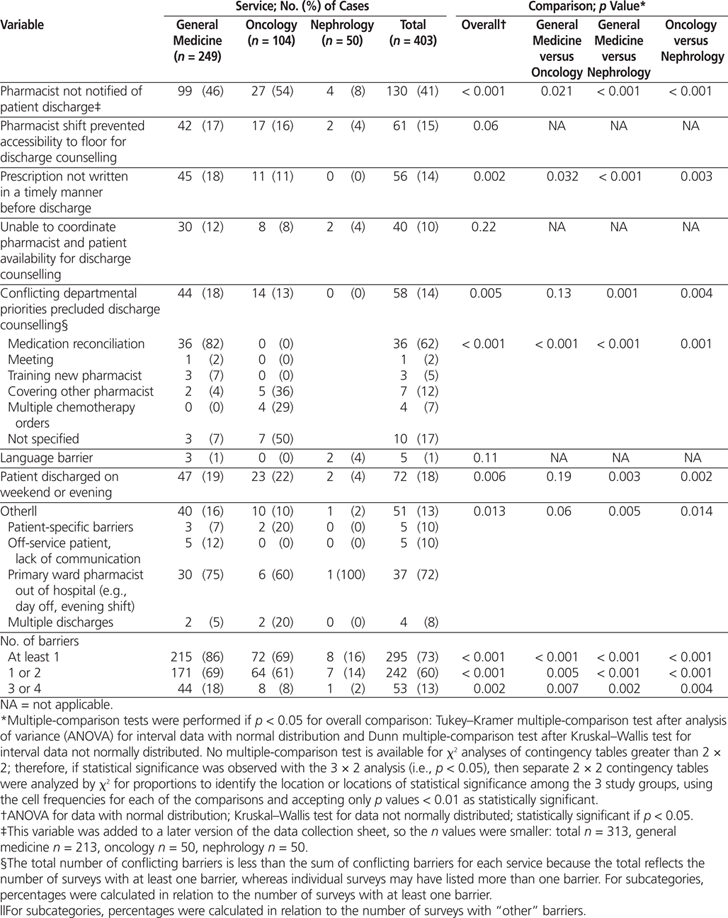
Table 3.
Time Constraints Related to Discharge Counselling
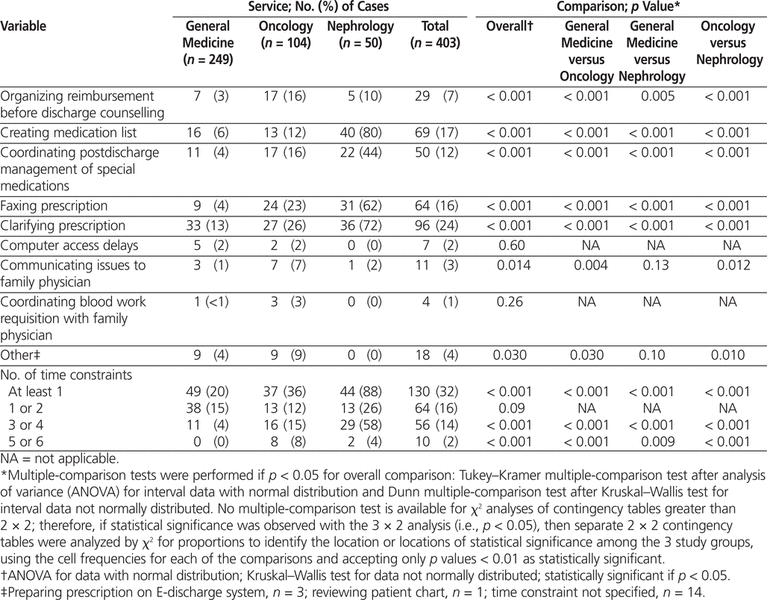
Table 4.
Time Spent by Pharmacists Preparing for Medication Discharge Counselling
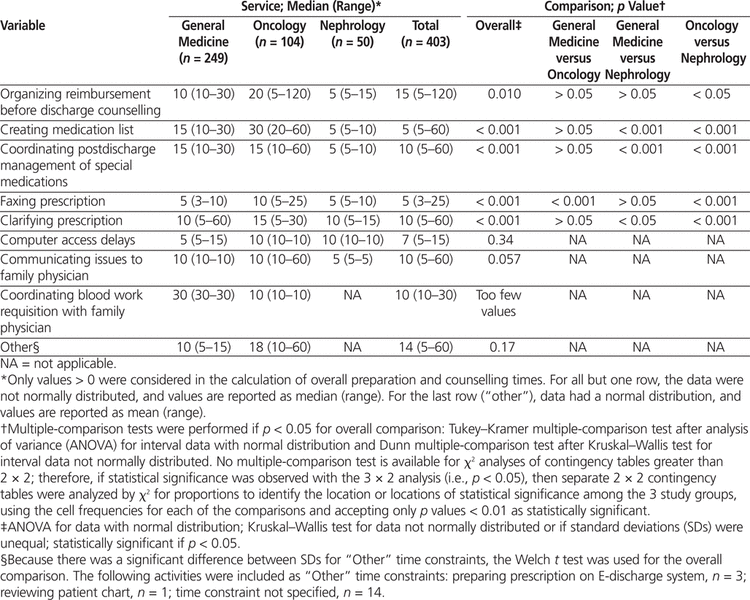
At least one barrier to discharge counselling was documented in 73% (295/403) of the surveys (Table 2). The time of notification before patient discharge was significantly shorter among patients who did not receive discharge counselling (2 h versus 4 h) ( p = 0.002) (Table 5), and all barriers except language occurred more frequently for patients who did not receive discharge counselling ( p ≤ 0.008) (Table 6). In fact, among cases in which discharge counselling did not occur, at least one barrier was present 99% (283/287) of the time. Conflicting departmental priorities represented a barrier for 57 of these patients (Table 6); performance of medication reconciliation for newly admitted patients was the most common conflicting departmental priority (36/57 [63%]) that prevented pharmacists from completing discharge counselling for patients who were ready to leave the hospital.
Table 5.
Time-Related Variables in Relation to Occurrence of Discharge Counselling
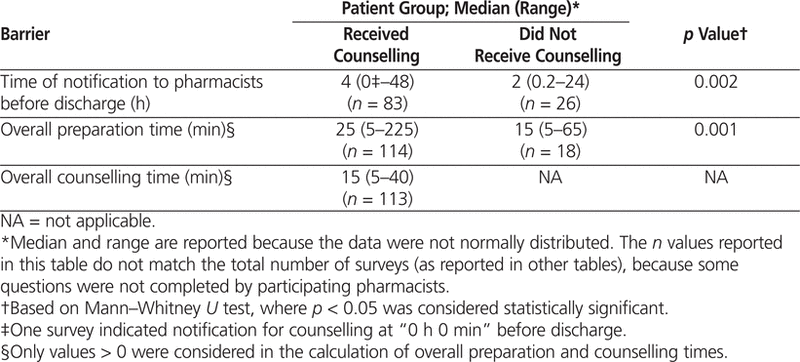
Table 6.
Barriers to Discharge in Relation to Occurrence of Discharge Counselling
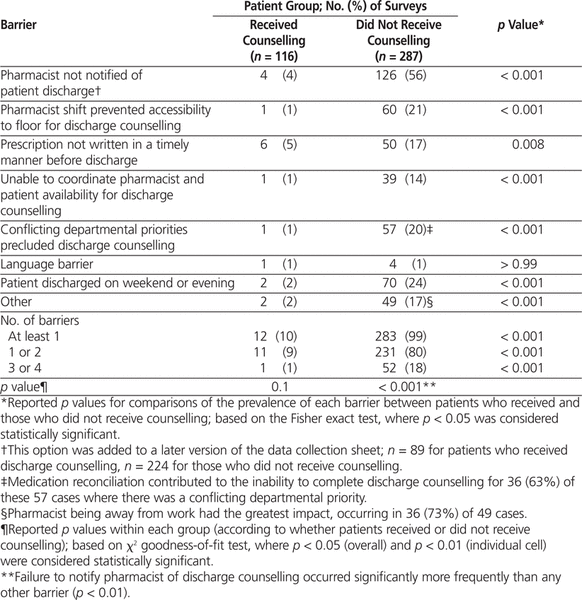
There was no difference in the incidence of any particular barrier in cases in which patients received discharge counselling ( p = 0.1) (Table 6). However, among patients who did not receive counselling, the incidence of various barriers did differ significantly ( p < 0.001) (Table 6). For example, failure to notify the pharmacist before discharge occurred more frequently than any other barrier (Table 6). Unfortunately, patients who did not receive discharge counselling were significantly more likely to have been discharged home on the weekend ( p < 0.001) (Table 6).
With the exception of coordination of blood work requisitions, all of the time constraints occurred more frequently among individuals who received counselling (Table 7). Among patients who received counselling, the most frequent time constraints were related to creating medication lists and clarifying prescriptions ( p < 0. 01) (Table 7). Among cases in which the patient did not receive medication discharge counselling, the need to clarify prescriptions occurred significantly more often than any other time constraint ( p < 0.01) (Table 7).
Table 7.
Time Constraints in Relation to Occurrence of Discharge Counselling
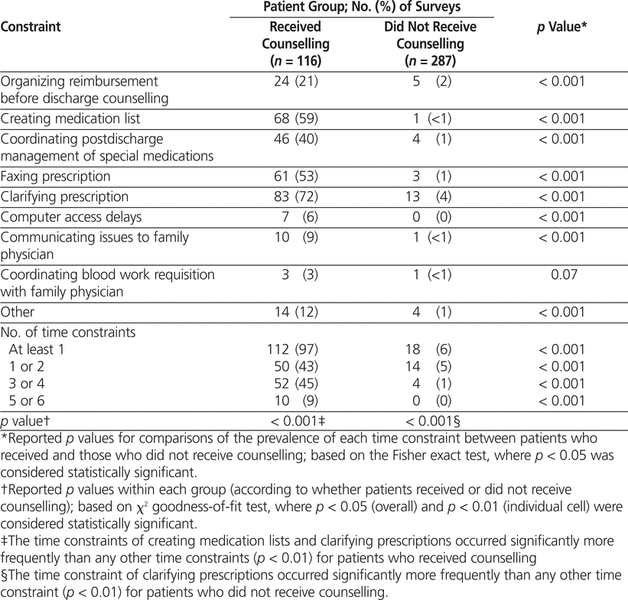
Medication errors have been shown to occur more frequently at discharge than at other times during a patient’s hospital stay, making discharge counselling an important part of the pharmaceutical care process.1,2 As experts in medication management, pharmacists are well suited to provide counselling to patients to improve transitions of care.5 The provision of comprehensive pharmaceutical care that includes pharmacist-conducted discharge counselling has been shown to reduce postdischarge hospital visits, emergency department visits, and drug-related readmissions, relative to standard of care without pharmacist involvement at the ward level.6 In addition to improvements in both inpatient and postdischarge outcomes, these clinical pharmacy services have also led to greater overall patient satisfaction.7 However, research evaluating the barriers to discharge counselling by pharmacists is currently limited.
In the current study, only 29% of eligible patients received discharge medication counselling by pharmacists because of several barriers to counselling. Similarly, in a qualitative study by Haynes and others,8 pharmacists reported that time pressure was a challenge to performing medication discharge counselling. To achieve the CSHP 2015 objective of providing discharge counselling to 75% of hospital inpatients with complex and high-risk medication regimens, methods of overcoming identified barriers to counselling are needed.
At the study institution, no automatic alerts to notify pharmacy staff of pending patient discharge are available through any hospital system (either the Admission, Discharge, and Transfer system or the E-discharge system). Although estimated discharge dates are entered manually into these systems, they are often arbitrary and unreliable. Pharmacists are notified of anticipated patient discharge by verbal com -munication from nurses or physicians (e.g., house staff, attending physicians, or hospitalists); however, no formal process exists for such notification. Discharge prescriptions are routinely prepared by physicians, with assistance from pharmacists only upon request. Because of high patient load, high patient turnover, multiple care teams, and medical complexity, many changes in patient care may occur throughout the admission, resulting in changes to medications right up to the day of discharge. Therefore, it is extremely difficult to pinpoint a patient’s discharge well ahead of time.
The general medicine and oncology units were well below the CSHP 2015 objective of providing counselling to at least 75% of patients who are discharged with complex and high-risk medication regimens. The nephrology service was the only unit to meet this standard. The process of discharge counselling was similar across all studied wards, with pharmacists receiving notification of a planned discharge, completing necessary preparatory tasks (e.g., obtaining discharge prescriptions, clarifying orders), and then performing the discharge counselling. Contributing to the variation in successful counselling rates were differences in patient populations, disease states, and clinical practices among the 3 services. In contrast to patients admitted to oncology and general medicine, and despite their complex comorbidities, patients on the nephrology service appeared to be a more homogeneous population. Given the chronic nature of their conditions, these patients are often readmitted, which allows pharmacists to become familiar with individual patients’ medicines and thereby facilitates discharge counselling. Additionally, the nephrology unit at the study facility is smaller (12 beds), with fewer admitted patients per pharmacist, than either the general medicine (21 beds per pharmacist) or oncology (18 beds per pharmacist) units, which potentially allows for more attention to each patient.
Patients who did not receive discharge counselling were more likely to have been discharged home over the weekend. The staffing complement of 3 dispensing pharmacists on weekends does not permit time for clinical activities, such as discharge counselling. Unfortunately, budget constraints limit the expansion of pharmacy services over the weekend. As a result, this barrier will not be overcome by the target year of 2015 to meet the CSHP’s practice excellence initiative.
This study has provided objective data regarding the barriers to and time constraints associated with medication discharge counselling by pharmacists, bringing awareness to the challenges that exist today for pharmacists in busy hospital positions, which may in turn provide data to support avenues of change for their hospital discharge counselling programs. The next steps in overcoming the identified barriers include increasing notification time for impending patient discharge through exploration of new communication systems, adopting web-based tools for writing discharge prescriptions, using electronic templates for creating medication lists, and developing innovative methods to handle the patient load for discharge counselling and medication reconciliation (e.g., by training pharmacy students and registered pharmacy technicians to perform some of the related tasks).
During the data-collection phase of this study, communication tools on the nursing units consisted of only whiteboards for patient information and an electronic paging system. With the introduction of electronic boards, the development of a computerized physician order entry system with pharmacy consult orders, and institution of daily communication e-mails between care providers, improved communication within the health care team is anticipated.
“E-discharge” is a web-based discharge program now used by the pharmacy and medical teams on the general medicine and nephrology wards. At discharge, physicians must populate the discharge medications section of the patient’s record from the medications-on-admission list and the inpatient active medications list; the resulting discharge summary includes a complete medication list and an electronic prescription. Although medication lists can be created from the E-discharge system, rate-limiting factors include the absence of automatic notification when a discharge prescription has been written, as well as health care workers’ lack of comfort with the tool. The use of electronic templates for creating medication lists, with modification of current web-based systems to facilitate accurate prescription-writing and to include electronic alerts for planned patient discharges, may reduce the need for prescription clarification and may improve the time allowed for pharmacist notification.
Along with improvements to current communication systems and electronic tools, delegation of pharmacy tasks will be needed to better manage patient load and regular pharmacy activities. Such delegation includes teaching registered pharmacy students and pharmacy technicians to obtain best possible medication histories for medication reconciliation, as well as teaching them to perform the technical aspects of discharge counselling, such as preparing medication lists. The involvement of pharmacy students and technicians will enable pharmacists to spend more time on the higher-level, complex aspects of discharge counselling.
Finally, it is important to discuss with CSHP whether the target of providing discharge counselling to 75% of patients with complex medication regimens is feasible by 2015 and also to encourage the organization to propose methods to help institutions succeed in attaining the CSHP 2015 vision.
This study has provided objective data regarding the barriers to and time constraints associated with medication discharge counselling by pharmacists, bringing awareness to the challenges that exist today for hospital pharmacists. More specifically, pharmacists at the study institution were not meeting the CSHP 2015 objective of providing counselling to at least 75% of patients who are discharged on complex or high-risk regimens.
These findings have helped pharmacists at the study institution to target specific areas and tools for both teaching and clinical practice, with the aim of improving discharge counselling programs. Whether the 75% target for discharge counselling proposed by the CSHP 2015 practice excellence initiative is feasible can only be determined after optimization of tools to overcome the barriers and will need to be prospectively evaluated.
The study also highlighted the need for CSHP to objectively re-evaluate the target of providing discharge counselling to 75% of patients with complex regimens in the short term and to assist institutions in meeting the CSHP 2015 vision by providing guidance on methods to improve the level of discharge counselling at Canadian hospitals.
1. Alibhai SM, Han RK, Naglie G. Medication education of acutely hospitalized older patients. J Gen Intern Med. 1999;14(10):610–6.


2. Canadian Hospital Pharmacy Residency Board. Accreditation standards 2010. Ottawa (ON): Canadian Society of Hospital Pharmacists; 2009 [cited 2013 Oct 9]. Available from: www.cshp.ca/programs/residencytraining/CHPRB_Standards_2010_-_FINAL.pdf
3. Medication reconciliation: statement on the role of the pharmacist. Ottawa (ON): Canadian Society of Hospital Pharmacists; 2009 [cited 2013 Oct 9]. Available from: www.cshp.ca/dms/dmsView/1_S_Med_Rec_2009.pdf
4. CSHP 2015 status: goals and objectives (May 2011). Ottawa (ON): Canadian Society of Hospital Pharmacists; 2012 [cited 2013 Oct 9]. Available from: www.cshp.ca/programs/cshp2015/docs/CSHP2015GoalsandObjectivesStatusReportMay2011.pdf
5. Moving forward to CSHP 2015 goals and objectives. A survey of hospital pharmacy directors and managers (2012). Ottawa (ON): Canadian Society of Hospital Pharmacists; 2012 [cited 2013 Oct 9]. Available from: www.cshp.ca/dms/dmsView/1_CSHP2015Survey_report_2012October.pdf
6. Gillespie U, Alassaad A, Henrohn D, Garmo H, Hammarlund-Udenaes M, Toss H, et al. A comprehensive pharmacist intervention to reduce morbidity in patients 80 years or older. Arch Intern Med. 2009;169(9):894–900.

7. Kaboli PJ, Hoth AB, McClimon BJ, Schnipper JL. Clinical pharmacists and inpatient medical care: a systematic review. Arch Intern Med. 2006;166:955–64.

8. Haynes KT, Oberne A, Cawthon C, Kripalani S. Pharmacists’ recommendations to improve care transitions. Ann Pharmacother 2012;46(9):1152–9.


*The CHPRB has recently been renamed the Canadian Pharmacy Residency Board. However, the former name was in effect when the 2010 accreditation standards were published and is therefore used in this article. ( Return to Text )
Competing interests: None declared.
Canadian Journal of Hospital Pharmacy , VOLUME 67 , NUMBER 3 , May-June 2014